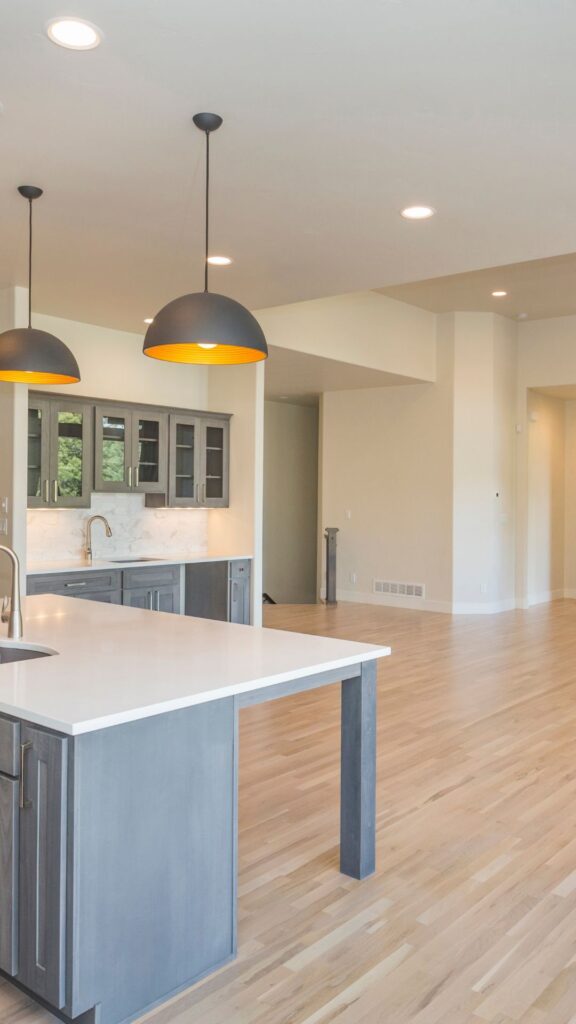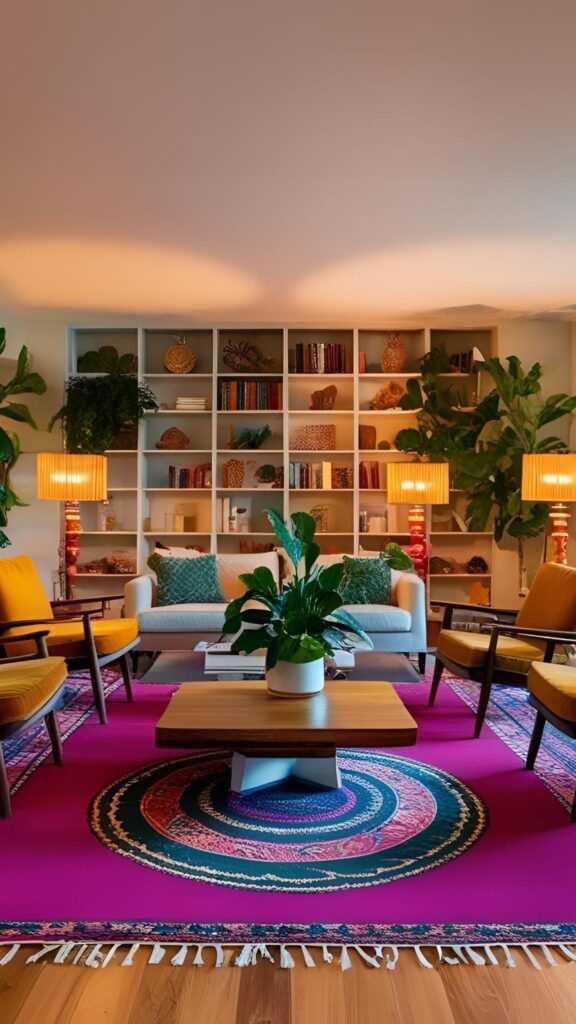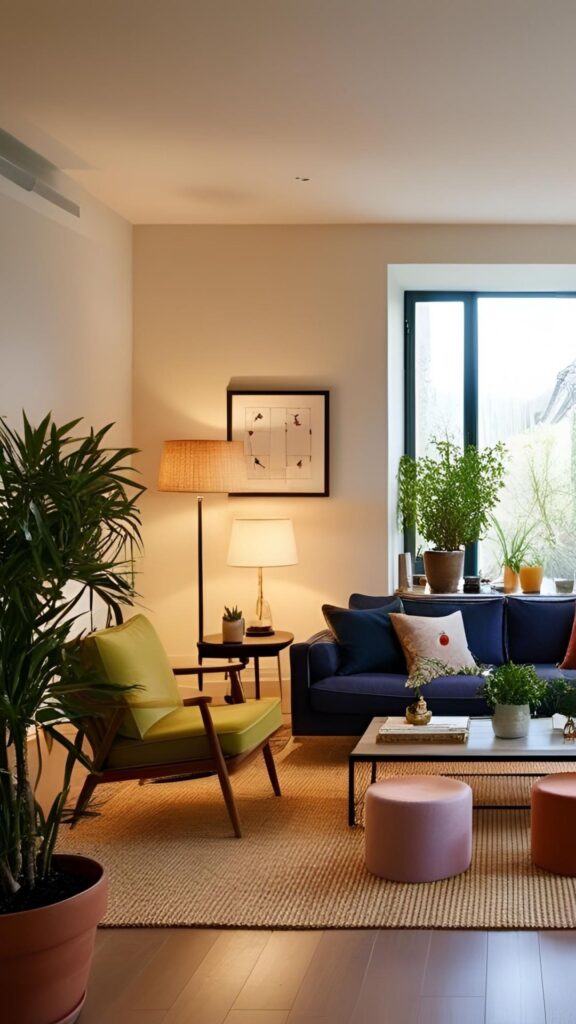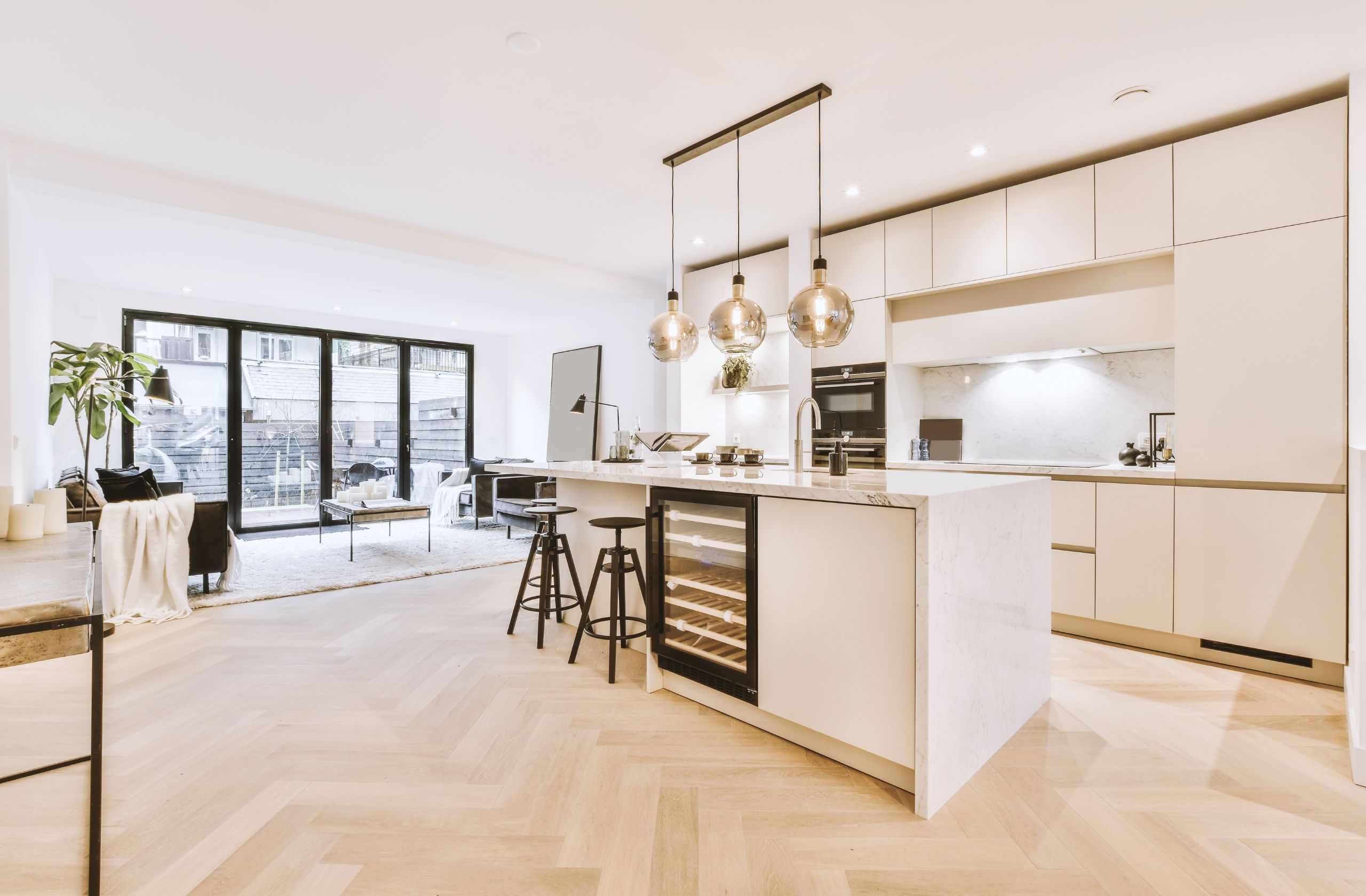An open-concept living room seamlessly blends multiple areas, such as the living, dining, and kitchen spaces, into one cohesive layout without dividing walls.
How do you arrange furniture in an open-concept living room?
You need to consider the flow and functionality of the space when arranging furniture in such settings. Start by identifying zones for specific purposes, like seating, dining, or entertaining.
Use rugs, lighting, or furniture placement to visually distinguish these areas while maintaining an open feel.
To achieve balance, ensure furniture proportions match the room’s scale.
Avoid overcrowding by leaving clear walkways.
Lastly, keep a consistent design aesthetic to tie the zones together, creating harmony across the entire layout.
How to Arrange Furniture In an Open-concept Living Room:
1) Evaluating Your Space: Measuring and Mapping

To design a functional open-concept living room, you must first assess your space methodically.
Begin by measuring the dimensions of the room, noting walls, windows, and entry points. Include fixed features such as fireplaces or built-in storage. Use a tape measure for accuracy, and record every detail.
Next, create a scaled map of the space, either digitally or on graph paper. Include measurements of large furniture pieces to visualize the layout. Account for walkways; aim to maintain at least three feet of clearance in thoroughfares. These steps help ensure proportional furniture placement and a cohesive design flow.
2) Define Separate Zones Without Walls

To effectively define zones in an open-concept living room, focus on using furniture placement, area rugs, and lighting as visual boundaries.
Anchor each zone with an area rug to establish its purpose. For instance, a plush rug under the seating area distinguishes the living space, while a sleek runner defines a dining or workspace.
Arrange furniture to create natural separations. Position a sofa or a console table to act as a divider between the living and dining sections.
Use lighting to emphasize these zones; pendant lights over the dining table and floor lamps in the seating area can guide the eye.
Incorporate decorative items strategically. For example, shelving units, screens, or plants can provide subtle division while maintaining an open feel.
3) Choose the Right Furniture for Open-Concept Layouts

Selecting the right furniture for an open-concept layout requires balancing practicality, aesthetics, and space flow. Begin by identifying the functional zones within your space, such as a living area, dining section, or workspace. Opt for furniture that visually anchors each zone. For instance, a sectional sofa can define the living space, while a rectangular dining table creates a focal point for meals.
Scale is crucial—choose pieces that fit proportionately to avoid overcrowding or an empty feel. Favor multifunctional items like storage ottomans or extendable tables for flexibility. Use area rugs, open shelving, or backless furniture to maintain sightlines and delineate spaces without disrupting openness.
4) Anchor Different Areas with Rugs

Rugs serve as powerful tools for defining and organizing various zones in an open-concept living room. You can use them to create distinct visual boundaries without structural divisions. When selecting rugs, consider the size and purpose of each area.
- Living Area: Choose a larger rug that allows all seating pieces to perch on it, or at least the front legs of furniture, unifying the space.
- Dining Area: Opt for a durable rug that accommodates your dining table and chairs, even when pulled out.
- Workspace or Reading Nook: Use smaller rugs to accentuate these zones, adding texture and personality.
5) Use Furniture to Create Natural Flow and Borders

In an open-concept living room, furniture placement is key to defining distinct spaces while maintaining a natural flow.
Strategically position items to visually separate areas without constructing physical barriers. For example, use a sofa with its back facing a dining space to delineate the living area.
Rugs can also anchor specific sections, like aligning a large rug under a seating arrangement to create a cozy gathering zone.
Consider pathways when arranging pieces. Leave enough clearance for easy movement while avoiding obstructions. Bookshelves or consoles can act as subtle dividers. Thoughtful placement ensures functionality without disrupting the room’s openness or aesthetic.
6) Incorporate Multi-Functional Furniture Pieces

Using multi-functional furniture in an open-concept living room is essential for maximizing space and enhancing flexibility. These pieces allow you to maintain a stylish aesthetic while optimizing functionality. Consider options like storage ottomans that double as seating or coffee tables with hidden compartments for keeping clutter out of sight. Sofa beds are perfect for creating a dual-purpose lounging and guest area.
To separate zones effectively, invest in shelving units that also serve as room dividers. Drop-leaf tables or extendable dining tables can adapt to different needs, from casual meals to hosting guests. Incorporating smart designs ensures each item serves multiple purposes harmoniously.
7) Balance Proportions with Furniture Placement

Achieving balance starts with assessing the proportions of your open-concept space. Arrange larger furniture pieces, like sofas or sectionals, first to anchor the room. Position them parallel or perpendicular to architectural features, such as windows or fireplaces, to create structure. Use smaller furniture, like chairs or ottomans, to complement the scale of larger pieces while filling gaps.
Distribute weight evenly by placing similarly sized items on opposite sides of the room. For example, balance a substantial entertainment center with a bookshelf or sideboard. Ensure paths between furniture remain at least 3 feet wide for flow and functionality. Thoughtful placement creates harmony without overcrowding.
8) Strategically Place Lighting to Enhance Each Zone

Proper lighting is essential for defining areas in an open-concept living room. Start by identifying the function of each zone—such as dining, lounging, or working—and select lighting that complements these purposes.
- For the living area, use soft, ambient lighting like floor lamps or wall sconces to create a welcoming and relaxed atmosphere.
- Over the dining area, focus on overhead fixtures, such as chandeliers or pendant lights, to center attention on the table.
- For the workspace or reading nook, task lighting like adjustable desk lamps is necessary for precision activities.
Decorative Tips for Cohesion and Style Across the Space
To create a harmonious open-concept living room, pay close attention to the decor elements that tie the area together. Start with a consistent color palette across all zones. Choose complementary hues for walls, furnishings, and accessories to ensure the space feels unified.
Incorporate area rugs to visually define different zones, but ensure their colors and patterns coordinate. Select lighting fixtures with similar finishes to maintain continuity. For furniture, use repeating materials like wood or metal to link pieces stylistically.
When accessorizing, distribute decor evenly across the space. Use matching throw pillows, artwork, or plants to visually connect seating areas and dining spaces.
Dealing With Common Open-Concept Layout Challenges
Open-concept layouts can be tricky to design due to their lack of defined boundaries. To overcome these challenges:
- Defining Zones: Use area rugs, furniture placement, or lighting to create distinct zones. For instance, a sofa or bookshelf can act as a visual divider between the living room and dining area.
- Balancing Flow: Arrange furniture to allow clear walking paths. Avoid blocking natural pathways between spaces to maintain accessibility.
- Harmonizing Styles: Ensure your furniture and decor have a cohesive color palette or materials, avoiding visual clutter as areas overlap.
- Managing Acoustics: Soften sound echoes by including textiles like curtains, cushions, and rugs, addressing the open space’s acoustical issues.
- Scaling Furniture: Select appropriately sized furniture to prevent the space from feeling too sparse or overcrowded.
Final Touches:
To make your open-concept living room truly inviting, focus on elements that enhance comfort and reflect your unique style. Start by layering textures like soft throw blankets, plush rugs, or accent pillows to create depth and warmth.
Use personal decor items, such as artwork, books, or meaningful collectibles, to infuse character into the space.
Lighting can also define personality—combine ambient, task, and accent lighting using table lamps, floor lamps, or pendant lights.
Incorporate greenery with indoor plants to add life and vibrancy.
Ensure pieces like ottomans or side tables are functional for convenience while keeping the layout uncluttered and welcoming.


